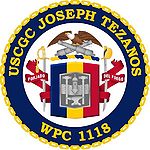JOSEPH TEZANOS WPC 1118
Ship Name and Designation History
This section lists the names and designations that the ship had during its lifetime. The list is in chronological order.
Sentinel Class 154 foot Patrol Boat Keel Laid - Launched |
 |
Naval Covers
This section lists active links to the pages displaying covers associated with the ship. There should be a separate set of pages for each name of the ship (for example, Bushnell AG-32 / Sumner AGS-5 are different names for the same ship so there should be one set of pages for Bushnell and one set for Sumner). Covers should be presented in chronological order (or as best as can be determined).
Since a ship may have many covers, they may be split among many pages so it doesn't take forever for the pages to load. Each page link should be accompanied by a date range for covers on that page.
- USCGC Joseph Tezanos WPC-1118 Covers Page 1 (DATE RANGE)
Postmarks
This section lists examples of the postmarks used by the ship. There should be a separate set of postmarks for each name and/or commissioning period. Within each set, the postmarks should be listed in order of their classification type. If more than one postmark has the same classification, then they should be further sorted by date of earliest known usage.
A postmark should not be included unless accompanied by a close-up image and/or an
image of a cover showing that postmark. Date ranges MUST be based ONLY ON COVERS IN
THE MUSEUM and are expected to change as more covers are added.
>>> If you have a better example for any of the postmarks, please feel free to replace the
existing example.
|
Postmark Type |
Postmark Date |
Thumbnail Link To Postmark Image |
Thumbnail Link To Cover Image |
|---|
|
POSTMARK TYPE |
POSTMARK DATE |
Note:
Other Information
NAMESAKE - Ensign Joseph Tezanos, USCG (1920-1985)
In spring 1942, 22-year-old Joseph Tezanos, a factory worker and Spanish immigrant, enlisted in the U.S. Coast Guard.
By May 1943, after a variety of temporary assignments, Tezanos received orders to report to New Orleans to serve on board a new LST, a large oceangoing landing craft whose abbreviated letters designated it as a tank landing ship. By July, Tezanos and his shipmates on board LST 20 would be part of a convoy headed for the Alaskan theater of World War II.
While serving on LST 20, he became a gunner’s mate, one of the most dangerous jobs aboard a World War II LST. Tezanos managed to survive some of the bloodiest amphibious landings of World War II, including those on enemy-held islands at Kiska, Alaska, Tarawa Atoll in the Gilbert Islands and Kwajalein Atoll in the Marshall Islands. At Tarawa, LST 20 supported the Marines as they slugged their way through what noted World War II Coast Guard historian Malcolm Willoughby termed “one of the most intensely fought amphibious operations of the entire war.”
In April 1944, LST 20 was moored near an armada of transports and LSTs in the West Loch area of Pearl Harbor, Hawaii, while preparing for Operation Forager, the invasion of the Japanese-held Mariana Islands. But before the armada could set sail, an explosion aboard one of the armada’s LSTs on May 21 set off a chain reaction among the fleet of heavily loaded transport vessels. The ensuing cataclysm killed 163 men and injured 396 others.
After the explosion, Tezanos scrambled aboard a rescue boat along with a gang of several other hastily assembled volunteers. The small boat and its intrepid crew steamed into harm’s way despite the risk of being burned alive or blown up. Tezanos and his shipmates rescued men in danger of drowning from the water and evacuated others from the burning ships. After receiving multiple burns in the line of duty, he helped save more than 40 people. For his actions that day, he was awarded the Navy and Marine Corps Medal, one of the highest medals awarded to Navy personnel for wartime rescue operations.
By summer’s end, LST 20 began preparing for its next operation, but Tezanos received orders to begin reserve officer training. In October, he found himself in New London, Connecticut, at the Coast Guard Academy. By early 1945, he graduated and became the first known Hispanic-American to complete the service’s Reserve Officer Training Program. His wartime commissioning in mid-January 1945 also qualified him as one of the service’s first Hispanic-American officers.
In May 1945, newly commissioned Ensign Tezanos returned to the West Coast to deploy as boat officer aboard the USS Joseph T. Dickman for the rest of the war. Most of that time saw his ship transporting troops to the front. Tezanos’ Coast Guard career would end in spring 1946.
If you have images or information to add to this page, then either contact the Curator or edit this page yourself and add it. See Editing Ship Pages for detailed information on editing this page.
Copyright 2025 Naval Cover Museum